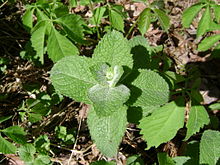Mentha suaveolens, the apple mint, pineapple mint, woolly mint or round-leafed mint (synonyms M. rotundifolia, Mentha macrostachya, Mentha insularis),[1][2] is a member of the mint family Lamiaceae. It is native to southern and western Europe including the Mediterranean region. It is a herbaceous, upright perennial plant that is most commonly grown as a culinary herb or for ground cover.
| Apple mint | |
|---|---|

| |
| Scientific classification | |
| Kingdom: | Plantae |
| Clade: | Tracheophytes |
| Clade: | Angiosperms |
| Clade: | Eudicots |
| Clade: | Asterids |
| Order: | Lamiales |
| Family: | Lamiaceae |
| Genus: | Mentha |
| Species: | M. suaveolens
|
| Binomial name | |
| Mentha suaveolens | |

Description
editApple mint typically grows to a height of from 40 to 100 centimetres (16 to 39 in) tall and spreads by stolons to form clonal colonies. The foliage is light green, with the opposite, wrinkled, sessile leaves being oblong to nearly ovate, 3 to 5 cm (1.2 to 2.0 in) long and 2 to 4 cm (0.8 to 1.6 in) broad. They are somewhat hairy on top and downy underneath with serrated edges. The flowers develop in terminal spikes 4 to 9 cm (1.6 to 3.5 in) long and consisting of a number of whorls of white or pinkish flowers. Apple mint flowers in mid to late summer. The plant is aromatic with a fruity, minty flavour.[3]
Taxonomy
editHybrids
editMentha suaveolens hybridizes with other Mentha species. Hybrids include:
- Mentha × villosa Huds. (hybrid with Mentha spicata)
- Mentha × rotundifolia (L.) Huds., 1782 (hybrid with Mentha longifolia)
- Mentha × suavis Guss., 1826 (hybrid with Mentha aquatica)
Varieties and cultivars
editThere are several varieties and cultivars commonly available[4] in horticulture:
- M. suaveolens 'Variegata' – common name pineapple mint – with variegated leaves and mauve flowers.[4]
- M. suaveolens 'Pineapple' – common name pineapple mint – with variegated leaves and creamy-white flowers.[4]
- M. suaveolens var. crispa 'Mojito' – with curled leaves and mauve-pink flowers.[4]
- Mentha suaveolens subsp. timija, an endemic Moroccan variety,[5] is known for its evergreen foliage and thrives along rivers in plains and mountains, displaying green leaves with a hairy texture.
Distribution
editApple mint is native to southern and western Europe and is naturalised in central and northern parts of Europe. It is found in damp and wet locations.[3]
Cultivation and uses
editAn attractive herb, apple mint is often used as an ornamental plant. It is hardy and easy to grow, preferring full sun to lightly shady conditions. The leaves of this plant can be used to make apple mint jelly, as well as a flavoring in dishes such as apple mint couscous. It is also often used to make a mint tea, as a garnish, or in salads.[6]
Pineapple mint (Mentha suaveolens 'Variegata') is a cultivar of apple mint that has leaves which are banded with white. A hybrid derived from it is grapefruit mint (Mentha suaveolens × piperata).
Apple mint has been used for medicinal purposes for thousands of years in many parts of the world, including Africa, Europe, Asia, and the Americas.[citation needed]
References
edit- ^ Quattrocchi, Umberto (1999). CRC World dictionary of plant names: Common names, Scientific Names, Eponyms, Sonyonyms, and Etymology. Vol. III M-Q. CRC Press. p. 1659.
- ^ BSBI List 2007 (xls). Botanical Society of Britain and Ireland. Archived from the original (xls) on 2015-06-26. Retrieved 2014-10-17.
- ^ a b "Mentha suaveolens (apple mint)". Kew Royal Botanic Gardens. Archived from the original on 2013-12-13. Retrieved 2013-12-10.
- ^ a b c d Royal Horticultural Society plant finder and selector https://www.rhs.org.uk/plants/search-results?form-mode=true&query=Mentha%20suaveolens
- ^ Kasrati, Ayoub; Alaoui Jamali, Chaima; Bekkouche, Khalid; Spooner‐Hart, Robert; Leach, David; Abbad, Abdelaziz (May 2015). "Chemical Characterization and Insecticidal Properties of Essential Oils from Different Wild Populations of Mentha suaveolens subsp. timija ( Briq .) Harley from Morocco". Chemistry & Biodiversity. 12 (5): 823–831. doi:10.1002/cbdv.201400236. ISSN 1612-1872.
- ^ "Mentha suaveolens". Plants for a Future. Retrieved 2013-12-10.
External links
edit- Pink, A. (2004). Gardening for the Million. Project Gutenberg Literary Archive Foundation.